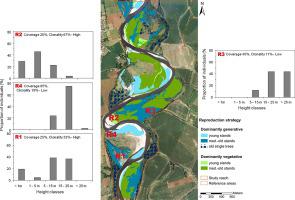Journal of Hydro-environment Research ( IF 2.4 ) Pub Date : 2020-03-26 , DOI: 10.1016/j.jher.2020.03.004 Elisabeth Tinschert , Gregory Egger , Juliane Wendelgaß , Berthold Heinze , Stewart B. Rood

|
The European black poplar (Populus nigra L.) is a riparian tree that dominates the early successional stages of alluvial floodplain forests throughout Continental Europe. River management and hybrid poplar plantations have contributed to the loss of this foundational species, and measures to conserve and restore the ecologically rich and diverse natural woodlands must sustain poplar reproduction. P. nigra is able to reproduce through either generative (sexual) or vegetative (asexual or clonal) processes and this enhances its chances for preservation in future forests. This research was undertaken to quantify the dominant reproductive strategy of natural black poplar stands, and to determine how this influenced woodland structure and successional processes within the floodplains along the lower Allier River. Two approaches were integrated: (1) analyses of the degree of clonality of stands based on DNA genotyping, sapling excavations, and the uniformity of poplar height and spatial distributions; and (2) retrospective analyses of successional processes to investigate spatiotemporal correspondences with the reproductive strategies. Structural stand patterns indicated the dominant reproductive strategy, with vertical heterogenity indicating clonality, while generative stands were more uniform. One half (50.2%, or 164 ha) of the floodplain study area supported woodlands with P. nigra stands or individuals. Of this area, 42% had apparently reproduced generatively with limited clonality; 43% had dominantly vegetative regeneration with high clonality; and 15% included generatively established, solitary old trees. The generatively and vegetatively reproduced stands displayed generally similar establishment rates but differed in their spatial patterns, with generative seedling bands or patches largely limited to barren streamside sites, while vegetative stands were more diversely distributed. The reproductive types also differed in successional dynamics, with generative stands providing more persistent successional phases with longer residence times. Thus, sexual reproduction enables woodland colonization and introduces genetic diversity, while clonal reproduction expands the population and structural diversity. Both reproductive strategies should be encouraged to provide healthy, diverse and resilient riparian woodlands.
中文翻译:

黑杨的替代繁殖策略影响法国艾里尔河沿岸林地内的多样性,结构和演替过程
欧洲黑杨(Populus nigra L.)是一棵河岸树,在整个欧洲大陆的冲积洪泛森林的早期演替阶段占主导地位。河流管理和杂交杨树人工林造成了这一基础物种的丧失,保护和恢复生态丰富多样的天然林地的措施必须维持杨树的繁殖。黑黑松能够通过生殖(性)或营养(无性或无性)过程繁殖,这增加了其在未来森林中保存的机会。进行这项研究是为了量化天然黑杨林林分的主要繁殖策略,并确定这是如何影响沿下游Allier河的洪泛区内林地结构和演替过程的。整合了两种方法:(1)基于DNA基因分型,幼树发掘以及杨树高度和空间分布的均匀性来分析林分的克隆程度;(2)连续过程的回顾性分析,以调查与生殖策略的时空对应关系。结构性林分模式表明了主要的繁殖策略,垂直异质性表明了克隆性,而生成林则更加统一。洪泛区研究区的一半(50.2%,即164公顷)支持林地黑黑松摊位或个人。在这个地区中,显然有42%的人以有限的克隆性繁殖。43%的人具有显性的植物更新能力,且具有较高的克隆度;15%的树种是由世代建立的孤独的老树。有生殖和无性繁殖的林分显示出大致相似的建立率,但它们的空间格局不同,有育苗的条带或斑块主要限于贫瘠的溪流地带,而无性繁殖林的分布更为多样化。生殖类型在演替动力学上也有所不同,生殖林提供了更持久的演替阶段和更长的停留时间。因此,有性繁殖使林地能够定居并引入遗传多样性,而无性繁殖则扩大了种群和结构多样性。










































 京公网安备 11010802027423号
京公网安备 11010802027423号